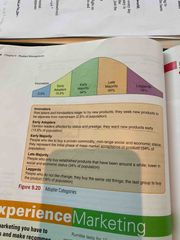![]()
![]()
![]()
Use LEFT and RIGHT arrow keys to navigate between flashcards;
Use UP and DOWN arrow keys to flip the card;
H to show hint;
A reads text to speech;
18 Cards in this Set
- Front
- Back
|
What are the product adopter categories |

Back (Definition) |
|
|
How are consumer products classified? |
Convenience: convenience goods are those goods purchased frequently, with a minimum of effort and evaluation (ex: food items such as bread, milk, cookies, chocolate bars) (convenience goods fall under the decision making process) Shopping: Shopping goods are goods that the consumer compares on such bases as suitability, quality, price and style before making a selection (ex: automobiles, clothing, major appliances, major repairs around the house) (other factors of concern to the shopper include dependability, service, functionality, guarantees and warranties) Specialty: Specialty goods are goods that consumers make an effort to find and purchase because they possess some unique or important characteristics. (In effect, the consumer has already decided what item to buy; it is simply a matter of making the shopping excursion to buy it) |
|
|
Individual branding strategies |
Each product in a company’s product mix has its own Common among large packaged-goods manufacturers such as Procter&Gamble and Kraft Canada |
|
|
Multi brand strategy |
Refers to the use of a different brand name for each item a company offers in the same product category (such as Nestlé chocolate snack market: Aero, Butterfinger, Coffee crisp, kit kat, rolo, smarties and turtles |
|
|
Family brand strategy |
A family brand exists when the same brand name is used for a group of related products. |
|
|
Co-branding |
Co-branding occurs when a company uses the equity in another brand name to help market its own brand-name product or service (two brand names on a product); also applies to toe organizations sharing common facilities for marketing purposes (ex: two restaurants in one location) |
|
|
Private label brand |
A brand produced to the specifications of the distributor (wholesaler or retailer), usually by national brand manufacturers that make similar products under their own brand names (ex: Canadian Tire with brands Mastercraft and Motomaster, Costco with brands Kirkland, Sobeys aka Thrifties with brands compliments) |
|
|
Generic brand |
A product without a brand name or identifying features |
|
|
Licensed brands |
Occurs when a brand name or trademark is used by a license |
|
|
Cult brand |
A brand that captures the imagination of a small group of devotees who then spread the word, make concerts, and help turn a fringe product into a mainstream name |
|
|
Brand loyalty |
Defined as the defer of consumer attachment to a particular brand of product or service |
|
|
Brand recognition |
Customer is aware of the name, benefit and package |
|
|
Brand preference |
Brand is top of mind and considered a good alternative. Consumer will buy if available |
|
|
Brand preference |
Brand is top of mind and considered a good alternative. Consumer will buy if available |
|
|
Brand insistence |
Consumer buys one brand only. If brand is not available, the purchase is postponed |
|
|
Brand equity |
Defined as the value a consumer derived from a product over and above the value derived from its physical attributes |
|
|
Brand manager |
An individual who is assigned the responsibility for the development and implementation of marketing programs for a specific product or group of products |
|
|
New product |
A product that is truly unique and meets needs that have previously been unsatisfied |

